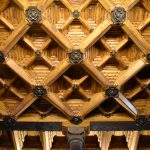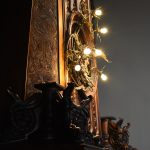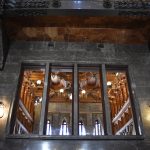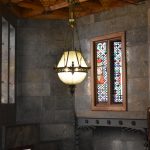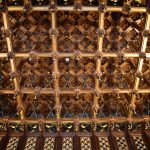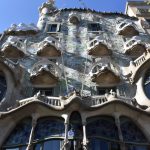As the UNESCO comments:
Seven properties built by the architect Antoni Gaudí (1852–1926) in or near Barcelona testify to Gaudí’s exceptional creative contribution to the development of architecture and building technology in the late 19th and early 20th centuries. These monuments represent an eclectic, as well as a very personal, style which was given free reign in the design of gardens, sculpture and all decorative arts, as well as architecture.
His work is rooted in the particular character of the period, drawing on the one hand from traditional Catalan patriotic sources and on the other from the technical and scientific progress of modern industry. Gaudí’s work is a remarkable reflection of all these different facets of society and has a unique and singular character. In fact, his works are particularly associated with Modernisme, and in this sense, Gaudí can be regarded as the most representative and outstanding of the Modernista architects.
Gaudí’s work is an exceptional creative synthesis of several 19th-century artistic schools, such as the Arts and Crafts movement, Symbolism, Expressionism, and Rationalism, and is directly associated with the cultural apogee of Catalonia. Gaudí also presaged and influenced many forms and techniques of 20th-century Modernism.
在巴塞罗那市区或近郊的7处安东尼·高迪的建筑作品,见证了他对19世纪末和20世纪初建筑技术的杰出创意与贡献。圭尔公园、圭尔宫、米拉大楼、文生宅圣家大教堂、巴特里奥之家和克洛尼亚古埃尔宫,这些建筑物都呈现了折衷主义风格,非常人性化,这对花园、雕塑以及所有装饰艺术和建筑的设计产生了极大影响。
(Below is the general introduction of a series of 6 posts about the 7 works by Antoni Gaudí protected by the UNESCO in and around Barcelona. If you have already read my first post “Works of Antoni Gaudí (1/7) – La Sagrada Familia” please skip the introduction part and jump below the horizontal line.)
In total there are 7 properties designed by Antoni Gaudí which are inscribed in the UNESCO World Heritage list. They are, Gaudí’s work on the Nativity façade and Crypt of La Sagrada Familia, Park Güell, Palau Güell, Casa Mila, Casa Vicens, Casa Batlló and Crypt in Colonia Güell.
Luckily, many thanks to the developed tourism industry of Barcelona, I was able to visit almost all the properties except Casa Vicens, which was still under reconstruction. It was a pity that I could only take a look at the exterior of the building but later on I read more about the interior on books. Hopefully when you visit Barcelona, the door of Casa Vicens will be open to you already.
In order to provide an insight into how to explore the works of Gaudí in a more organized manner, I’d like to write about these 7 properties in 6 not-too-long posts, namely “la Sagrada Familia”, “Casa Mila”, “Casa Batlló”, “Park Güell”, “Palau Güell”, “Crypt in Colonia Güell and Casa Vicens”, just in case if you only want to visit some of the 7 buildings, you don’t need to scroll down a super-long post to find out where to go or what to see.
My general structure of introducing these properties would be first of all, some practical information based on my own experience such as opening hours and buying tickets. Secondly, I’ll focus on what I’ve learnt from my visit (audio guide or books) and I’ll try offering some highlights combined with pictures. I believe in this way, it’s easier to understand the cultural and historical value of Gaudí’s works and his influence. If you have any questions, please do not hesitate to contact me or contact the Tourism Office of Barcelona directly, I assure you they will handle your questions or requests efficiently. Now, let’s start our journey of exploring the masterpieces of God’s architect, Antoni Gaudí.
Situated in the historic center of Barcelona, Güell commissioned Gaudí to build a palace instead of a house for him and his family. This is actually the first big project that Gaudí took from Güell and this palace had been the home of Güell till he moved to his residence in Park Güell. This palace was built between 1886 and 1888 and Güell intended to make it the meeting point for Barcelona’s high society during the 1888 Barcelona Universal Exhibition, which was an event of worldwide importance that revolutionized the city. Do you remember this exhibition was also mentioned in my previous post about Park Güell?
In order to “show off” his wealth while holding concerts or exhibitions, Güell expected this palace to be a masterpiece. Thanks to Gaudí, he achieved this goal when people refer to it as “Babylonian”, not only because of its exterior appearance or the size, but also because of the very best materials used while construction, ranging from top-quality woods to delicate marbles, from multicolored stained glass to wrought ironwork and ceramics. According to Gaudí’s own interpretation, these materials recreate an atmosphere of Gothic style and of Muslim art.
Featured in Gaudí’s works, symbolism is indispensable. Since the time it was finished, the whole palace has been open to various interpretations of people in Barcelona. Some people say the basement, made of hard materials, represents the hell and the central lounge, made of the most refined materials, represents the earth. On the top, the roof terrace together with the colorful chimneys , made poetic materials such as multicolored ceramics, represents the sky. Some other people interpreted that Gaudí wanted to use the design of this palace to describe Güell’s life, from the dark basement of poverty to the festival colors on the top, bathing in the golden sunlight of wealth. In chapter two I’ll focus more on the detailed symbolic features of each floor and I hope you can have a better understanding of how the details of Palau Güell were carefully considered by Gaudí.
This palace is composed of 5 floors with 2 mezzanines and 1 flat roof terrace. From the bottom to the top they are the basement, the ground floor, the mezzanine, the main floor, the mezzanine floor, the bedrooms, the attic and the roof terrace. In chapter two I’ll show you what each floor or mezzanine looks like and what they were used for.



1. Practical information
1.1 Opening hours
Palau Güell is in general open from Tuesday to Sunday during:
Summer opening hours (1st April – 31th October) from 10:00 to 20:00 (ticket office closes at 19:00)
Winter opening hours (1st November – 31th March) from 10:00 to 17:30 (ticket office closes at 16:30)
Closed: Mondays (except public holidays), 25th and 26th December, 1st January and the third week of January (for maintenance).
Palau Güell Open Day:
The Open Days of Palau Güell are: the first Sunday of each month, 12th Febrary (Santa Eulàlia, co-patron saint of Barcelona), 23th April (Sant Jordi, the patron saint of Catalonia), Nit dels Museus (The Night of Museums), 11th September (Catalan national holiday) and 24th September (La Mercè, the patron saint of Barcelona).
If you happen to visit Palau Güell on one of its Open Days, it is free of charge but you have to pick up free tickets on the same day at the ticket office.
The limited (for conservation, preservation and security reasons) free tickets will be distributed in two shifts:
Winter season (1st November – 31st March): from 10:00 to 13:30 and from 13:30 to 16:30.
Summer season (1st April – 31st October): from 10:00 to 15:00 and 15:00 to 17:00.
1.2 Various ticket prices
Please note that renting of audio guide is included in your admission ticket. To be honest, I was really shocked when I learnt that Palau Güell provides so many kinds of audioguides. For example, general audio guide in 8 languages (Catalan, Spanish, English, French, Italian, German, Japanese and Portuguese), express audio guide in 8 languages, young people’s audio guide in 7 languages (without Portuguese), audio guide with audio commentary for the blind and partially sighted, video guide in sign language for the deaf and the hearing impaired, audio guide with on-screen transcriptions for non-signing deaf or hearing impaired people. How considerate is this place!
If you don’t want wait in the line to buy tickets, you can easily book your tickets online. You can book normal tickets or guided tours in Catalan, English, French or Spanish. Please click here to book the tickets from the official website. Below I’ll show you different prices (General price 12 €, discounted price 9 €, mini price 5 € and free admission).
General price: 12 €
Discounted price: 9 €
Discounted admission fees apply (with proof of eligibility) to:
- Students aged 18 and over.
- Single-parent families.
- Large families.
- Groups of adults aged over 18 and over accompanied by a guide or teaching staff (from 10 to 25 people, booked in advance).
- European Union citizens aged 65 and over.
- Users of the Ruta del Modernisme (Modernisme Route).
- Users of the Barcelona Card or Barcelona Express.
Mini price: 5 €
Mini admission fees apply (with prior of eligibility) to:
- Groups of students aged under 19 years of age accompanied by a teacher (10-25 people, booked in advance).
- Organised groups of disabled or dependent people plus 2 accompanying people (5 -15 people, booked in advance).
- Children and young people aged 10 to 17 (both inclusive).
- People with a disability rating under 65% or with 1st or 2nd degree of dependence.
- Holders of the Targeta Rosa discount card.
- Holders of the Barcelona province library network card (Xarxa de Biblioteques Municipals de la Diputació de Barcelona card) or cards of others public libraries of Catalonia.
- Holders of the Young Card (Carnet Jove).
Free admission applies (with proof of eligibility) to:
- Members of International Council of Museums/ International Council on Monuments and Sites (Spanish Committee)/Association of Museologists of Catalonia.
- Unemployed people who are residents of Spain.
- Guides or teachers accompanying a group (1person per group).
- Official tourist guides of Catalonia.
- Children under 10 years of age.
- Staff of the Barcelona Provincial Council.
- Spanish state-employed teachers (individually).
- People with a disability rating of 65% or higher or 3rd dregree of dependence of higher, (plus 1 accompanying person).
- Holders of the Barcelona Press Card.
- Holders of the Targeta Rosa free card.
If you are traveling by group, please click here for more information.
1.3 Guided tours
This one-hour guided tour is probably the best way to discover the hidden secrets in Palau Güell. From the stable in the basement to the chimneys on the roof terrace, it will be much easier for you to discover the ornamental details, or let’s say Gaudí’s genius, guided by a professional, who knows so much about this place. What’s more, you will learn about the history of the palace as well as how the Güell family lived here over a decade ago. Isn’t this experience exciting? And is it expensive? No! The price is again included in your admission ticket. However, whether you’re buying your ticket online or on site you need to choose guided tour ticket or tell the salesperson about it. Otherwise you’re only gonna get a normal ticket with free audio guide. The schedule is as following:
- Every Friday at 12 am and Saturday, at 10.30 am, in French.
- Every Friday at 10.30 am and Saturday, at 12 am, in English.
- Every Sunday, a 10.30 am, in Spanish.
- Every Sunday, at 12.30 am, in Catalan.
1.4 How to get here
Address: Carrer Nou de la Rambla 3-5, 08001 Barcelona
Metro: Line 3 to station Liceu.
Bus: buses No. 14, 59, 91, 120 and Bus Turistic have stops close to the palace.
If you still have questions, please don’t hesitate to contact me or click here to contact the official website of Palau Güell.
2. Explore this palace-house
Eusebi Güell, born in Barcelona, with a solid humanistic background, deep religious convictions and a deep-rooted Catalanist patriotism, was a bold pioneering businessman, industrialist and politician. He was also the patron of many artists in Barcelona, among which Antoni Gaudí stood out. As I’ve explained in my previous post about Park Güell, Gaudí and Güell are much more than an artist and a patron, but true friends. Their friendship, collaboration, shared belief and taste created many of the world’s most precious and famous works, among which some are inscribed into the UNESCO World Heritage list.
As written in the brochure “Tour map”, which you can obtain when buying your admission ticket or at the entrance, Gaudí’s works can be divided into two main periods, that is to say,
In the earlier phase, in which he was inspired by oriental art and the neo-Gothic, a desire to break with formal established codes was already becoming obvious. This urge to renew would culminate in Güell Palace, a work in which Gaudí introduced most of the elements that would form the basis of his subsequent repertoire.
The later, the mature phase of his work, coincides with the dawn of Art Nouveau in Catalonia. It represents the final superseding of any reference to historicist styles and the achievement of modelling and structural forms of his own, that is, what would later be known as Gaudinian aesthetics.
It is here in this palace that Gaudí applied his creative and ingenious solutions. For example, the conception of space, the use of different kinds of materials, the treatment of light and the rich decorative, symbolic details. All in all, a deeply understanding of this building forms the basis for the understanding of his later works.
As I mentioned before, the audio guide or guided tour is included in the admission ticket. To explore this palace at your own pace or to be guided by a well-knowledged professional, whichever way you prefer. From the next section on, I’ll introduce to you floor by floor where Gaudí’s intelligence and creativity hide and what these rooms were used for when the Güell family lived here. So this is not only gonna be a tour of architecture, but also a tour of history and culture.


Before entering the palace, take a look at the façade and the iron gates. Gaudí made full use of the materials that came from the owner’s properties. For example, the façades of this building were built using the stone from Garraf. Can you notice any symbols related to the construction, the region or Güell family? I think the most notable thing is the coat of arms of Catalonia, situated between the two iron gates. It is indeed a bold design as people can tell it is the coat of arms of Catalonia but somehow it’s totally different. If you take a look at the real coat of arms of Catalonia you you soon realize the difference. First of all, instead of vertical bars, the ones in this design rise in a spiral over a cylinder and on both side become winding ribbons. Instead of a crown topped by a dragon or bat, in this design the top part turns out to be a helmet crowned by a phenix, symbol of rebirth, referring to the Renaixença, an early 19th-century romantic revivalist movement in Catalan language and culture, akin to the Galician Rexurdimento or the Occitan Félibrige movements. At the top middle, you can discover Gaudí’s graphic design of the number 1888, the year that this palace was completed and of the Universal Exhibition. Take a close look at the iron gates, can you see the initials of Eusebi Güell? They are on the upper part of the iron gates, another great design made of wrought iron by Gaudí. Now let’s start exploring this masterpiece from the bottom to the top.
2.1 The basement



The basement stables were built from thick bricks columns and is connected with an inner courtyard by two parabolic arches supported by a central column. The basement is features by a gentle ramp which the horses used to go up and down and a steep cobbled spiral ramp which the people used.
2.2 The ground floor



Once you enter from the street to the palace you are in the vestibule on the ground floor. For us visitors nowadays, you will find the audio guide counter, left-luggage office, information center, gift shop and WC. However, about a decade ago, it was on this floor that the doorman and coachman services were carried out. Here were the coach house, where the carriages were kept, a storage area for farming products, the doorman’s quarters and a booth from which the doorman could watch the street.
Once you’re on your way up to the first mezzanine, you’re stepping on the marble stairway, designed by Gaudí using the finest materials.
2.3 The mezzanine


The mezzanine between the ground and the first floor housed Eusebi Güell’s business office and other rooms used for administration and archiving, such as the library. Here we will also find the vestibule to the living quarters and staircase.
2.4 The main floor



If you want me to recommend some highlights in this palace, besides the roof terrace, I’d say the main floor (first floor) is the one on which you should spend the most of your time. It is on this floor that you will see
- the antechamber (entrance to the main floor),
- the Hall of Lost Steps (This room is featured with a big open gallery with plenty of light and overlooks the outside street. It is through this room that the visitors will enter the Central Hall),
- the visitors’ hall and dressing room (The visitors’ hall, most notable for its ceiling made of top-quality woods with wrought iron and golden leaves, was where the visitors waited before entering the Central Hall, and the dressing room adjoining it was mostly used by female guests during parties or concerts),
- the hall of intimates (used mostly for gatherings or conversations with the closest friends) and the bay window room or smoking room (which has a gallery with ten windows overlooking the inner courtyard),
- the dining room (it preserves the original dining table and twelve chairs used by the family, and a walnut fireplace designed by Camil Oliveras. Also noteworthy are the wooden dado rails around the walls, decorated with animals of an oriental influence, by the same architect.),
- the billiard room (also used as a studio for sculpting and painting by the Güell children),
- the southern terrace and rear façade (you can see from here that the closure of the gallery of the rear façade provides privacy of the interior space while allowing adequate fresh air to pass through),
- the corridor (connecting Güell Palace to the family house on La Rambla, where Eusebi’s Güell’s father lived until his death. This was also where Eusebi Güell’s children displayed the works of art and antiques that they collected.)
- and most importantly, the Central Hall (I’ll focus on explaining the Central Hall after the pictures).
Below are the pictures of the places (number 1 to 9) that I mentioned above (arranged in order and each picture is for one place except that the Central Hall has two pictures).
The Central Hall is undoubtedly the most important masterpiece and the concentrate of Gaudí’s genius and creativity in Palau Güell. Taking space of more than 80 square meters and being as high as the palace (17 meters), this well-lit hall is where all the rooms are positioned around. More importantly, this place is closed by a revolving paraboloid, which is covered with marble plaques full of holes, allowing the light to filter through and imitating a celestial vault through which the stars shine brightly. This parabolic arch with a geometric shape appeared frequently in almost all his later works. As you can see on the second picture of this section, doesn’t it look like the dark sky filled with stars?
Of course, this hall wasn’t designed for Güell’s guests to look at the fake stars. It was used for concerts and sometimes religious services. As you can see from the sixth picture in the first photo gallery in this section, the closet-chapel is a small room closed off by two large doors that, when opened, revealed the altar.
“When concerts were held here, visitors sat on the hall level with the organ keyboard; the orchestra was on the floor above; above that, the singers, and above them the organ pipes. This meant the music emerged from all around, a totally Wagnerian concept.”
How I wish I could experience a concert like this here.
2.5 The second mezzanine between the main floor and the bedroom floor


Here was where the musicians sat for concerts. The main Palau Güell kitchen also used to be on this floor.
2.6 The bedroom floor (second floor)
This floor was used privately by the Güell family, which included the parents’ and children’s bedrooms and bathrooms. Therefore here is the best place to take a glance of this tech family’s private life. For example,
- The hall of intimates
- Isabel Güell’s bedroom and dressing table (this room contains a stained glass window depicting Macbeth and Hamlet. Gaudí designed a very original dressing table in Isabel Güell’s bedroom, which is the property of the descendents of the Güell family.)
- the bedroom of Isabel López (features a wrought iron arabesque and gold decoration on the columns)
- the bedroom of Eusebi Güell
- The bathroom, toilets and the blue room (all the walls are covered in tiles from the Pujol i Bausis factory, with plants and geometric patterns)
Below are the pictures of the rooms (number 1 to 5) that I mentioned above (arranged in order and each picture is for one room).
What’s also noteworthy is a permanent exhibition held here called “Palau Güell: A Look at Furniture“. The exhibition is divided in two phases: “The Güell family decor” and “The interior designers of Modernisme“. The first one shows the original furniture that decorated the palace when Eusebi Güell and his familiy were living here while the second one exhibits the “Modernisme” furniture owned by the Barcelona Provincial Council.


2.7 The attic
Nowadays this attic is just one area but when the Güell family lived here, it was divided into eleven bedrooms for the servants plus a laundry room and a kitchen. The large windows are decorated with stained glass designed by Gaudí using the trencadís, mosaic technique applied to glass. When I visited Palau Güell, on this floor there was a temporary exhibition called “Photographies of Ramon Manent”.
2.8 The roof terrace


It is right here on this roof terrace that Gaudí for the first time applied his multicolored architectural characters, turning traditional chimneys into colorful, creative sculptures in amazing shapes, a forerunner of Casa Batlló and Casa Milà. These twenty sculptural chimneys are places around a 15-meter high spire, which is also the skylight of the Central Hall. On top of the spire is the weather vane, in the shape of a bat, over a sun compass and beneath the Greek cross.
As I mentioned above, exploring this palace is of vital importance to the understanding of Gaudí’s later works and either an audio guide or a guided tour is strongly recommended. I suggest you have a general idea of the plan of the building first because otherwise it is possible that you will get lost. A house built as a palace, it is the work of Gaudí that you shouldn’t miss.
This post is one of my 6 posts concerning the 7 Works of Antoni Gaudí protected by the UNESCO. If you are interested, please click on the following properties to read more about them.
- Nativity façade and Crypt of La Sagrada Familia
- Casa Mila
- Casa Batlló
- Park Güell
- Palau Güell
- Crypt in Colonia Güell and Casa Vicens

